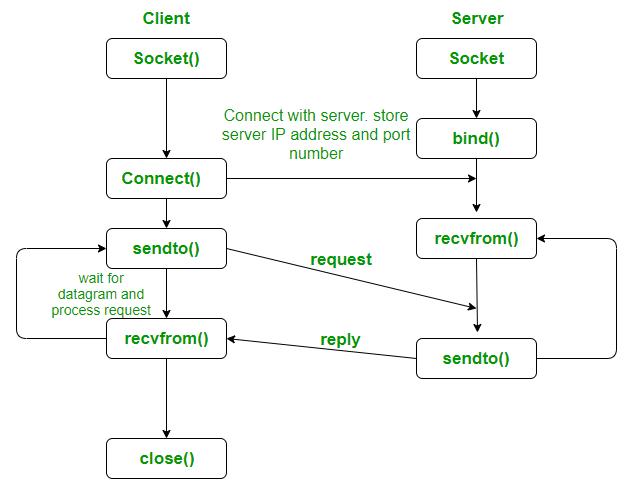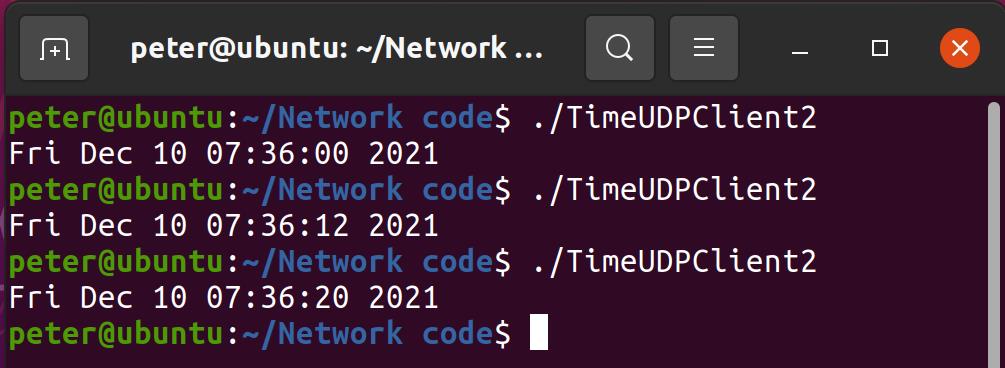针对TIME服务的UDP客户软件的实现(附源码含注释)
Posted 秒五
tags:
篇首语:本文由小常识网(cha138.com)小编为大家整理,主要介绍了针对TIME服务的UDP客户软件的实现(附源码含注释)相关的知识,希望对你有一定的参考价值。
俗话虽说宇宙机人要善于复制,但博主还是希望各位能理解其中的原理,最好亲手实现一遍,毕竟三维空间中自己经历过的是记忆中最深刻的,且远比二维空间中的文字阅读要深刻。
鉴于博主的阅历有限,文章有失误或者疑惑的地方还望多多指出,开了提醒的我会第一时间交流回复,和各位同伴一起进步呀(ง •_•)ง
实验原理:UDP客户端交互模式
步骤一:引入头文件
#include <sys/types.h>
#include <unistd.h>
#include <stdlib.h>
#include <string.h>
#include <stdio.h>
#include <errno.h>
#include <sys/socket.h>
#include <netinet/in.h>
#include <arpa/inet.h>
#include <netdb.h>
#include <stdarg.h>
#include <time.h>
步骤二:Time服务客户端所需函数声明以及宏定义
#define BUFSIZE 64
#define UNIXEPOCH 2208988800UL
#define MSG "what time is it?\\n"
#define LINELEN 128
#ifndef INADDR_NONE
#define INADDR_NONE 0xffffffff
#endif
/*UDP链接*/
int connectUDP(const char* host, const char* service);
/*连接函数*/
int connectsock(const char* host, const char* service, const char* transport);
/*报错并退出*/
int errexit(const char* format, ...);
步骤三:主函数的实现,定义本机IP和服务名,连接套接字后向服务器发送数据(请求Time服务),接着接收数据(Time),并将接收到的数据从网络字节顺序转换成主机字节顺序,再转换成UNIX时间并打印输出
int main(int argc, char *argv[])
char *host = "localhost";
char *service = "time";
time_t now;
int s, n;
switch (argc)
case 1:
host = "localhost";
break;
case 3:
service = argv[2];
case 2:
host = argv[1];
break;
default:
fprintf(stderr, "usage: UDPtime [host [prot]]\\n");
exit(1);
s = connectUDP(host, service); //套接字
(void)write(s, MSG, strlen(MSG)); //发送数据(请求)
n = read(s, (char*)&now, sizeof(now)); //接收数据(时间)
if (n < 0)
errexit("read failed: %s\\n", strerror(errno)); //若无返回数据,报错
now = ntohl((unsigned long)now); //网络字节顺序转主机字节顺序
now -= UNIXEPOCH; //转换成UNIX时间
printf("%s", ctime(&now)); //打印接收到的数据(时间)
exit(0);
步骤四:connectUDP函数的实现,调用connectsock函数选择UDP连接
int connectUDP(const char* host, const char* service)
return connectsock(host, service, "udp");
步骤五:connectsock函数的实现,实现所有分配和连接TCP/UDP套接字的操作(连接的实现)
int connectsock(const char* host, const char* service, const char* transport)
struct hostent* phe; //主机信息
struct servent* pse; //服务信息
struct protoent* ppe; //协议信息
struct sockaddr_in sin; //网络端点地址
int s, type;
memset(&sin, 0, sizeof(sin));
sin.sin_family = AF_INET;
/*匹配服务名和端口号*/
if (pse = getservbyname(service, transport))
//sin.sin_port = pse->s_port;
sin.sin_port = htons(5188);
else if ((sin.sin_port = htons((unsigned short)atoi(service))) == 0)
errexit("can't get \\"%s\\" service entry\\n", service);
/*匹配主机名至IP地址(允许点分十进制)*/
if (phe = gethostbyname(host))
memcpy(&sin.sin_addr, phe->h_addr, phe->h_length);
else if ((sin.sin_addr.s_addr = inet_addr(host)) == INADDR_NONE)
errexit("can't get \\"%s\\" host entry\\n", host);
/*匹配传输协议名至协议号*/
if ((ppe = getprotobyname(transport)) == 0)
errexit("can't get \\"%s\\" protocol entry\\n", host);
/*通过协议选择套接字类型*/
if (strcmp(transport, "udp") == 0)
type = SOCK_DGRAM;
else
type = SOCK_STREAM;
/*分配套接字*/
s = socket(PF_INET, type, ppe->p_proto);
if (s < 0)
errexit("can't create socket: %s\\n", strerror(errno));
/*连接套接字*/
if (connect(s, (struct sockaddr*)&sin, sizeof(sin)) < 0)
errexit("can't connect to %s.%s: %s\\n", host, service, strerror(errno));
return s;
步骤六:报错函数的实现
int errexit(const char* format, ...)
va_list args;
va_start(args, format);
vfprintf(stderr, format, args);
va_end(args);
exit(1);
实验结果:成功访问Time服务~

完整源码
#include <sys/types.h>
#include <unistd.h>
#include <stdlib.h>
#include <string.h>
#include <stdio.h>
#include <errno.h>
#include <sys/socket.h>
#include <netinet/in.h>
#include <arpa/inet.h>
#include <netdb.h>
#include <stdarg.h>
#include <time.h>
#define BUFSIZE 64
#define UNIXEPOCH 2208988800UL
#define MSG "what time is it?\\n"
#define LINELEN 128
#ifndef INADDR_NONE
#define INADDR_NONE 0xffffffff
#endif
/*UDP链接*/
int connectUDP(const char* host, const char* service);
/*连接函数*/
int connectsock(const char* host, const char* service, const char* transport);
/*报错并退出*/
int errexit(const char* format, ...);
int main(int argc, char *argv[])
char *host = "localhost";
char *service = "time";
time_t now;
int s, n;
switch (argc)
case 1:
host = "localhost";
break;
case 3:
service = argv[2];
case 2:
host = argv[1];
break;
default:
fprintf(stderr, "usage: UDPtime [host [prot]]\\n");
exit(1);
s = connectUDP(host, service); //套接字
(void)write(s, MSG, strlen(MSG)); //发送数据(请求)
n = read(s, (char*)&now, sizeof(now)); //接收数据(时间)
if (n < 0)
errexit("read failed: %s\\n", strerror(errno)); //若无返回数据,报错
now = ntohl((unsigned long)now); //网络字节顺序转主机字节顺序
now -= UNIXEPOCH; //转换成UNIX时间
printf("%s", ctime(&now)); //打印接收到的数据(时间)
exit(0);
/*第二过程 选择TCP或UDP连接*/
int connectUDP(const char* host, const char* service)
return connectsock(host, service, "udp");
/*第三过程 连接的实现(分配和连接TCP/UDP套接字)*/
int connectsock(const char* host, const char* service, const char* transport)
struct hostent* phe; //主机信息
struct servent* pse; //服务信息
struct protoent* ppe; //协议信息
struct sockaddr_in sin; //网络端点地址
int s, type;
memset(&sin, 0, sizeof(sin));
sin.sin_family = AF_INET;
/*匹配服务名和端口号*/
if (pse = getservbyname(service, transport))
sin.sin_port = pse->s_port;
else if ((sin.sin_port = htons((unsigned short)atoi(service))) == 0)
errexit("can't get \\"%s\\" service entry\\n", service);
/*匹配主机名至IP地址(允许点分十进制)*/
if (phe = gethostbyname(host))
memcpy(&sin.sin_addr, phe->h_addr, phe->h_length);
else if ((sin.sin_addr.s_addr = inet_addr(host)) == INADDR_NONE)
errexit("can't get \\"%s\\" host entry\\n", host);
/*匹配传输协议名至协议号*/
if ((ppe = getprotobyname(transport)) == 0)
errexit("can't get \\"%s\\" protocol entry\\n", host);
/*通过协议选择套接字类型*/
if (strcmp(transport, "udp") == 0)
type = SOCK_DGRAM;
else
type = SOCK_STREAM;
/*分配套接字*/
s = socket(PF_INET, type, ppe->p_proto);
if (s < 0)
errexit("can't create socket: %s\\n", strerror(errno));
/*连接套接字*/
if (connect(s, (struct sockaddr*)&sin, sizeof(sin)) < 0)
errexit("can't connect to %s.%s: %s\\n", host, service, strerror(errno));
return s;
/*报错*/
int errexit(const char* format, ...)
va_list args;
va_start(args, format);
vfprintf(stderr, format, args);
va_end(args);
exit(1);
以上是关于针对TIME服务的UDP客户软件的实现(附源码含注释)的主要内容,如果未能解决你的问题,请参考以下文章
针对TIME服务的UDP客户软件的实现( Linux + Socket + C + Code + Annotation)
针对TIME服务的UDP客户软件的实现( Linux + Socket + C + Code + Annotation)
基于SpringBoot的客户关系管理系统的设计与实现(附源码)